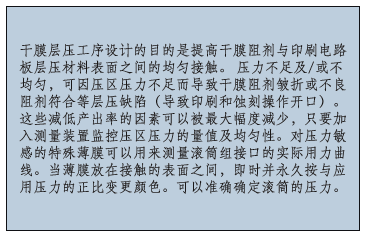
Maintaining the correct, uniform pressure in the lamination process can increase yields by reducing opens and eliminating dry film wrinkles.
The dry film lamination process is designed to enhance uniform contact between the dry film resist and the surface of the PCB laminate material. The viscosity of the resist is lowered by the addition of heat transmitted through the rolls. The resist can then flow to conform to the surface topography of the substrate. By applying a pressure differential across the rolls, adhesion is enhanced, and the pressure may be transmitted to the lamination rolls pneumatically, hydraulically, mechanically or by a combination of these means.
Insufficient pressure and/or non-uniform pressure can lead to lamination defects such as dry film resist wrinkles or poor resist conformation (that can lead to opens in the print and etch process) caused by insufficient nip pressure.
1-9 These yield detractors can be minimized by the addition of a measuring device to monitor nip pressure magnitude and uniformity. Specialized films
10 that are pressure sensitive are available to measure the actual force profile at the interface of the roller set. The pressure indicating film is placed between the two rolls before closing the nip, and after applying pressure, an image is captured on the pressure indicating film, revealing both the pressure distribution and the magnitude, commonly called the “footprint” of the rollers.
Films are available that measure pressure from 2 psi to 43,200 psi (0.14 kg/cm
2 to 3,000 kg/cm
2), and when the film is placed between contacting surfaces, it instantaneously and permanently changes color directly proportional to the actual pressure applied. The precise pressure magnitude is easily determined by comparing color variation results to a color correlation chart (
FIGURE 1).
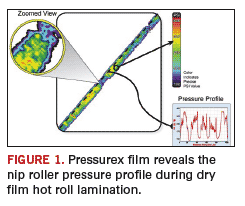
During dry film lamination, it is possible for the photo resist to wrinkle or bubble. By carefully monitoring both pressure magnitude and distribution of pressure across the lamination rollers through the use of pressure-indicating films, wrinkling-induced defects can be significantly reduced. The primary contributor to intermittent wrinkling is over tightened, loose or worn roller chucks that cause roller misalignment and imperfect nips.
In a standard hot roll laminator, the force on the resist is not measured directly. A pressure gauge measures pressure applied to the pneumatic cylinders that close the lamination rolls. The actual force on the resist depends on the design of the roll loading system, taking into account the actual area of the cylinders and the mechanical leverage, if any, of the system. Since the force is applied to the resist through an elastomeric roll covering, it is distributed as pressure (force per unit area). It is dependent on the width of the board and the width of the roll nip’s footprint, as influenced by the total force applied, the roll diameter and the thickness and durometer of the roll covering. The pressure across the footprint varies from zero at the edges to some peak pressure at the center of the nip, where the roll covering is compressed the greatest.
The average of this pressure profile (roughly described by a parabola) is about two-thirds of the peak pressure. Nip pressure is the average pressure, not the peak pressure, because it is easier to determine. To keep things simple, however, we will talk about nip forces in terms of force per unit length of board width (pounds per inch or Kilograms per centimeter), ignoring the actual width of the footprint.
This test can also be conducted while a resist covered copper clad laminate is inserted between the rolls. This test gives insight into the potential problem of “bowing” of rolls, especially with thicker boards, and the test can measure the effectiveness of so- called “crowned rolls”
2 in counteracting bowing and in achieving a uniform pressure profile across the panel. Roll bending is illustrated in
FIGURE 2.
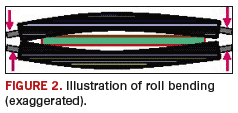
The impact of roll bending on the process depends on a variety of parameters. Hot roll laminators that work at relatively low loads and feature large diameter rolls are less prone to roll bending. Roll bending affects outer layer dry film lamination more than innerlayer dry film lamination because the thickness of the multilayer boards is enough to allow roll bending. Thin boards or panels permit the rolls to touch on either side of the panel, reducing the tendency to bend. The model suggests that the thickness of the dielectric core, plus copper and resist thickness, must be greater than 22 mils (550 micron) before defects are noticed. When roll bending occurs, the center of the panel is laminated at a lower pressure than the edges. This can result in a higher level of opens and dish-down defects along the center of the panel, in machine direction and in print and etch applications.
To measure improved resist conformation at higher pressures, AOI was used to test for circuitry defects which are associated with poor resist conformation such as opens, nicks, dish-downs and line thinning on a print and etch test pattern. The laminator parameters were set with air pressures of 4 bar and 7 bar on an ASL-24 automatic sheet laminator (
TABLE 1). The two pressures correspond to forces of 36 lbs/in and 62 lbs/in, respectively. At the higher pressure, defects were reduced 79% from the lower pressure level. While this is a significant reduction, it is difficult to take advantage of the higher pressure because the lamination rolls bend under the increased pressure.

Roll bending results in an uneven roll footprint on the resist, one that is narrower at the center and wider at the ends. This means that the pressure on the resist at the center is less than at the ends. Laminator suppliers are aware of this phenomenon and try to build the rolls as sturdy as is practical. Residual roll bending can be compensated for with rolls that are crowned.
2 A crowned roll has a rubber covering which is thicker in the center than at the edges and changes gradually from center to edge, resulting in a curved profile. The correct amount of crown for the ASL-24 Laminator is in the range of 3 mils to 4 mils (75 microns to 100 microns).
FIGURES 3 and
4 illustrate footprints caused by a bending straight roll and a crowned roll.
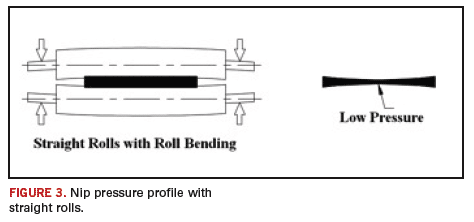
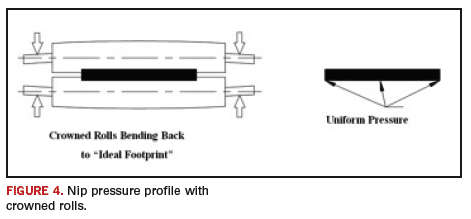
Table 1 shows how crowning reduces the circuitry defect count both in the low- and high-pressure modes, the best case being high-pressure and crowned rolls. Rubber suppliers, such as Robinson Rubber and Abba Rubber International Inc., are able to supply such crowned rolls.
FIGURE 5 maps open defects for different pressures and roll profiles. The beneficial effect of higher pressure is evident. Also, for straight rolls that are bending, one can see the high abundance of opens in the center of the board in machine direction, where the pressure is lowest due to roll bending.
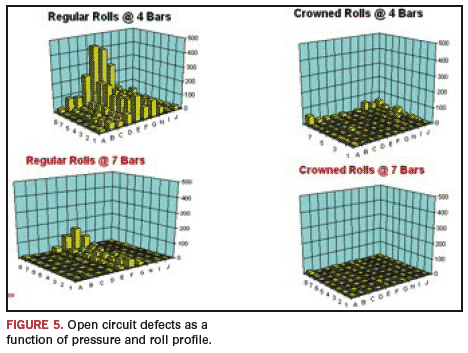
With regard to maximizing the applied nip loading, equipment design is the limiting factor. The strength of the rolls and the roll-loading mechanism usually limits the load, although available air pressure can be a constraint at some locations. The available force can be concentrated in a very narrow footprint by reducing roll diameter and the thickness of the covering, but this aggravates the roll strength and bending issue.
Tackling Wrinkles
A properly aligned and maintained hot roll laminator, as seen in
FIGURE 6, is the first step towards wrinkle-free lamination. If the laminator is adequately aligned and maintained, many of the sources potentially contributing to wrinkling problems may not actually result in wrinkles.
FIGURE 7 shows lamination wrinkles pointing in one direction. The likely causes for this type of wrinkling are rolls closing on the right side before the left side or if the closing force is greater on the right hand side.
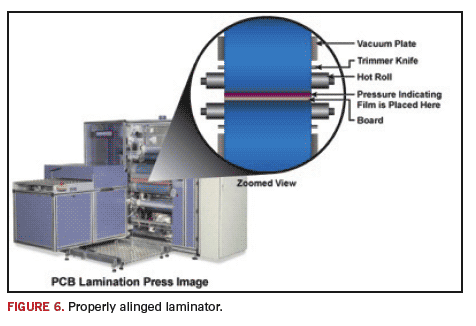

A general rule is that wrinkles, on a reasonably maintained laminator, are a problem only when laminating wide (>510 mm; >20 in) resist or when laminating very thin (< 0.2 mm; <0.008 in) laminate materials.
Roll Bending
Laminator rolls bend when subjected to loading, and the bending causes higher driving speeds greater at the edges than in the center of the panel. While it usually does not affect the panels, except for very thin laminate, it can drive the resist film in a way that the film edges tend to move toward the middle, resulting in lamination wrinkles. If the loading is high enough to iron out the wrinkles during the time the film is being held by the vacuum bar, the wrinkles may not appear until the very end of the cut sheet, when the film is dropped by the vacuum bar. At this point, there is no restraint of the trailing edge, and the last inch or so is likely to gather and to wrinkle. Frequently, “comet tails”, a defect that creates a tail coming out from a tooling holes, is caused by a combination of roll bending and poor control of the resist trailing edge.
Uneven Air Cylinder Pressures
The clamp pressures (the air cylinders that close the rolls) must be set at the same pressure for wrinkle-free lamination. This source may be one of the biggest causes of long wrinkles that start mostly at the middle of the panel and move back at a small angle to the lamination direction. The gauges are not always reliable indicators for the actual pressure, so a periodic independent pressure check is advisable.
Post-Lamination (PL) Wrinkles
These wrinkles appear after lamination and run in the machine direction (
FIGURE 8). The PL wrinkles can have a variety of causes, one of which can be excessive lamination pressure. PL wrinkles are caused by heat and stress in the polyester base.

While the need for good conformation requires as high a lamination pressure as possible, this pressure can add to the stress in the base. If PL wrinkles are a problem, it would be better to use two nips set at medium pressures and temperatures than one nip at high pressure and high temperature. The second nip should be directly after the first one to minimize heat loss between nips. Note that this arrangement would be more useful on multilayer panels than on innerlayers.
In conclusion, maintaining correct and uniform pressure across a hot roll laminator nip, e.g., through the use of pressure sensitive indicator film, is a useful process quality assurance technique for the detection and the correction of roll misalignment, as well as pressure that is too low, excessive or uneven. Such conditions can lead to poor resist conformation and/or Dry Film lamination wrinkles– which in turn will lead to yield losses.
PCD&FJeffrey G. Stark is president of Sensor Products, Inc and can be contacted at
This email address is being protected from spambots. You need JavaScript enabled to view it.. Karl H. Dietz is a technical writer residing in Raleigh, N.C. and can be contacted at
This email address is being protected from spambots. You need JavaScript enabled to view it..
REFERENCES
- The Role of Dry Film Lamination in the Making of Ultra-Fine Pitch PC Boards, Edward Hagan, Technical Paper S12-4, Proceedings, Printed Circuits Expo ’98, Long Beach, CA, April 26-30, 1998.
- Using Crowned Rolls to Compensate for Roll Bending, E. F. Hagan, Technical Bulletin TB-9739 Rev. 1.0 (7/97), DuPont Photopolymer & Electronic Materials.
- “Effects of Lamination Parameters on Dry Film Photoresist Conformation,” Edward F. Hagan, Technical Paper F9, Proceedings, IPC Works ‘96, October 19-25, 1996, Naples, FL.
- Fine Lines in High Yields, (Part XXVIII): Advances in Hot Roll Lamination of Dry Film Photoresist (Part A), Karl H. Dietz, CircuiTree Magazine, December 1997, p. 60.
- Fine Lines in High Yields, (Part XXIX): Advances in Hot Roll Lamination of dry film Photoresist (Part B), Karl H. Dietz, CircuiTree Magazine, January 1998, p. 18.
- Dry Film Lamination Process Effects of Lamination Parameters on Wrinkling and Dimensional Properties of Dry Film and Copper Clad Laminate, E. Hagan & K. Dietz, Technical PaperFilm S05-2, Proceedings, IPC Printed Circuit Expo ’99, March 14-18, 1999, Long Beach, CA.
- The Process of Dry Film Lamination (Part I), Karl. H. Dietz & Edward F. Hagan, PC Fab, September 1999, Vol. 22, No. 9, p. 42.
- The Process of Dry Film Lamination (PartII), Karl. H. Dietz & Edward F. Hagan, PC Fab, October 1999, Vol. 22, No. 10, p. 38.
- Fine Lines in High Yields, (Part CXXXV): The Effects of Lamination Roll Mechanics on Conformation, Karl H. Dietz, CircuiTree Magazine, December 2006, p. 64.























